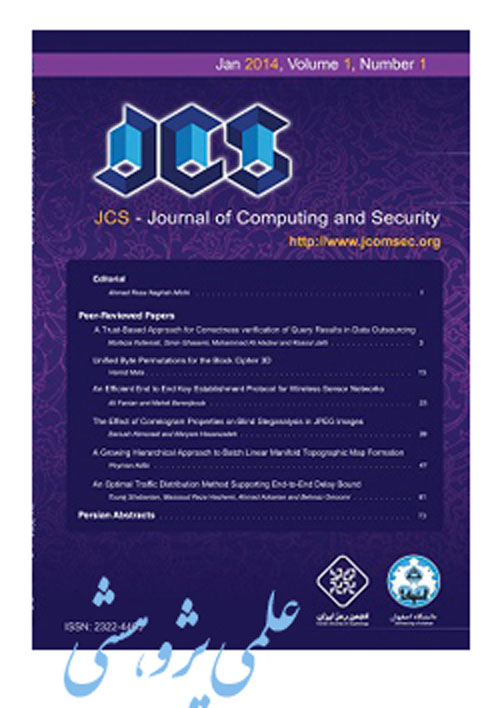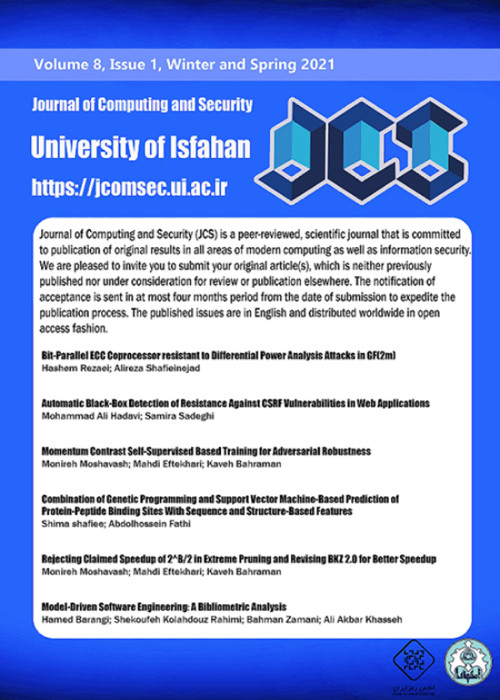فهرست مطالب

Journal of Computing and Security
Volume:4 Issue: 1, Winter and Spring 2017
- تاریخ انتشار: 1396/02/02
- تعداد عناوین: 3
-
-
Pages 3-12Social secret sharing, introduced in 2010 by Nojoumian et al., allows to share a secret among a set of participants whose authorities can vary over time. However, existing social secret sharing schemes are only capable of sharing one secret during each execution. To overcome this drawback, in this paper, we employ symmetric encryption schemes to propose a social multi-secret sharing scheme. It is proved that the proposed scheme provides computational security in the active mobile adversary. Moreover, to indicate the efficiency of the proposed scheme, comparison with existing (single) social secret sharing schemes is provided.Keywords: Secret Sharing, Social Secret Sharing, Symmetric Encryption, Computational Security, Trust Model
-
Pages 13-23Application of soft computing hybrid models have been concentrated to cope with uncertainty in the medical expert systems, recently. Heart disease is one of the mortal diseases that can be controlled in early stages. In this paper a hybrid Fuzzy-GA model for the Heart Disease Prediction (HDP) problem has been proposed. For this, first a Fuzzy Expert System (FES) using Mamdani model was presented. Then the membership functions parameters of the FES were optimized using the hybrid Fuzzy-Genetic Algorithm (Fuzzy-GA). The reason of selecting fuzzy method was its high potential to address the uncertainty sources in the knowledge of medical experts. Performance of the FES and Fuzzy-GA model were evaluated using a real dataset of 380 patients collected from Parsian Hospital in Karaj, Iran. Accuracy of the designed FES before optimization was 85.52%. After optimization using the hybrid Fuzzy-GA, the accuracy of this system was increased to 92.37%. The proposed hybrid model competes with its counterparts in terms of interpretability and accuracy in prognosis process of the heart disease. This model is promising for early diagnosis of the heart disease and saving more people lives.Keywords: FES, Genetic Algorithm, Fuzzy-GA System, HDP
-
Pages 25-38This study has two main objectives; first, to evaluate student perceptions on the technological aspects of the e-learning system, Second, to propose a model to determine the relationship between the technological factors and the perceived usefulness of e-learning. The main contribution of this paper is to propose and test six hypotheses that reinforce the relationship between technological aspects of e-learning and its perceived usefulness. A questionnaire survey of quantitative research methodology was applied and data was collected using an adapted survey instrument. The respondents were 306 Diploma of Engineering students. The findings revealed that four out of these six factors, namely the ease of access to portal, student-lecturer interaction, adequate technical support, and quality of Internet connectivity have a major influence on the perceived usefulness of e-learning. It is envisaged that the model can be very useful in increasing the usefulness and acceptance of e-learning in higher education institutions.Keywords: E-Learning, Technological Aspects, Student Perception, Perceived Usefulness


